
You are reading the older HTML site
Positive Feedback ISSUE
40november/december 2008
mbl
Reference Line 6010D preamplifier (with Phono Option)
as reviewed by Marshall Nack
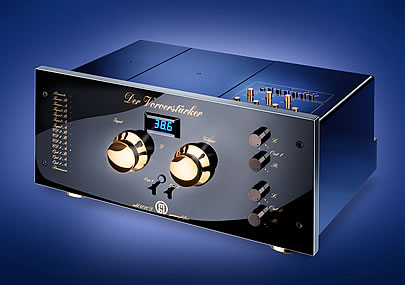
|
Day 1: Take 1. I was listening to the radio and kept hearing Aaron Copland's familiar Fanfare for the Common Man melody interspersed among sections of unfamiliar orchestral music. All of Copland's ingratiating middle period hallmarks were present and I found it irresistible. I put down my book—what was this known, yet unknown pastiche? As much as the composition it was the sound that riveted my attention. In particular, timbral bloom and the solidity underpinning instruments were stunning. It gave me the distinct impression of an advanced power supply at work.
Then the announcer informed it was Copland's Symphony #3 with Leonard Slatkin and the St. Louis Symphony Orchestra. I must look that one up—I love coming upon new compositions like that.
Once before I had experienced such a massive upgrade upon the addition of a new component, when my ancient $70 Proton FM tuner instantly became competitive with my finest, many times more expensive, sources.
This was my first impression of the mbl 6010D preamp.
Day 1: Take 2. Maestro of the Met: James Levine and Friends (DG 449 229-2), a compilation of highlights from Levine's first decade with the Metropolitan Opera orchestra.
From the opening blasts of the brass choir on track 1, I'm aware of a different acoustical space before me. Those volleys emanate from deep stage left. You "watch" as their trails roll across the stage, fading away somewhere deep right, defining the rear of the hall in the process. Levels of texture and subtle tonal variation are on display that are so transparently delineated as to startle. This current illusion is quite unlike previous ones. It is not that the images are laser sharp or have pronounced 3-D depth. The impression is created without recourse to the usual imaging games of spotlighting or etched outlines. In the present illusion, exact stage dimensions don't seem to matter, because what's happening perfectly meets your expectations and is wholly unforced.
About one minute in, the thwack of the bass drum makes me push REPLAY. (I'm not getting very far into the recording. I keep hitting REPLAY because all I need to hear is in the first minute.) I'm used to that drum agitating the couch I'm sitting on with low-frequency waves that ride under the rest of the orchestra, but when those notes come out now it is not some homogeneous hunk of tone—this is what a synthesizer produces. I can discriminate repeated mallet thwacks followed by rippling pulses. The pulsing action tells me the speaker woofers are expertly damped, responding to minute changes even within the heavy SPL onslaught.
When I finally move to track two, Luciano Pavarotti's voice floats out with a difference. More of his vocal apparatus is on display, less of the component straining under the burden of the signal. He sounds like a mensch.
the mbl Noble Line 5011 preamp
Before talking further about the 6010D, I want to back up and look at
mbl's mid-line 5011preamp. With some high-end manufacturers, top-notch
grades are achieved in the one-down product in their line. I consider
the mbl 5011preamp to be such a product. I gave it outstanding grades
when I
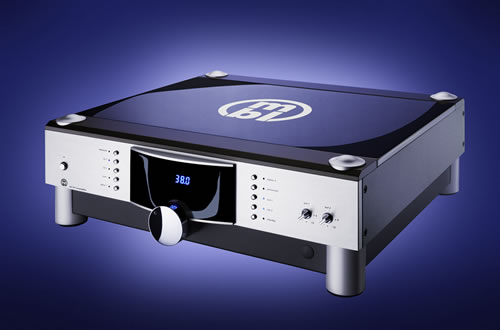
With the Noble Line 5011 (MSRP $10,550), mbl achieved something close to reference level—maybe it is there, if one defines "reference level" to be a product that does it all out of the box, one that doesn't need its voice repaired for any perceived shortfalls. Its shortcomings are only revealed in comparison to the very best.
The 5011 is characterized by a smooth, slightly warm and dark frequency response, notably fulsome body, and a certain kind of purity or freedom from the telltale clues that would identify it as solid-state. It has great dynamics, abundant low-end, and sounds direct, immediate and slightly forward.
The Reference Line 6010D (MSRP $23,800) takes all that as its jumping off point. If you look at the specs (available on the web), you'll find the numbers closely match. In fact, some of the 5011's specs—Signal to Noise ratio and Channel separation—are even better, and you can hear this in the presentation.
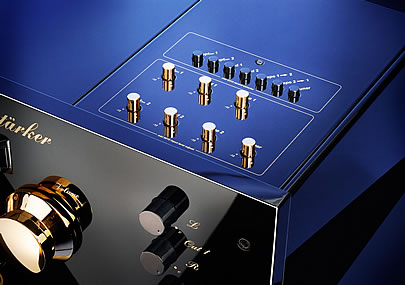
But don't get the impression that a 6010D is just a souped-up 5011 with better parts. I know the sound of my mbl 5011 preamp driving my mbl 8011 AM monoblocks intimately, including their limitations. For example, when confronted with a strong impulse response as when John Abercrombie slaps his electric guitar hard and overloads the pickup, an instantaneous concussion-like transient is generated on Marc Copland : Another Place (Pirouet PIT3031, an excellent new jazz label, by the way, producing discs with an ECM kind of mood).
How the 6010D Excels
But put the 6010D in front of the 8011 AMs and guess what? The transient seems to double up. Can it be that attributes like headroom and damping begin forming in the preamp, so that when the signal is passed to the amp it has a well-formed foundation to build upon? I'm not an engineer so I'm speculating here, but it seems to me that the preamp and the power amp have some overlapping functions—they work hand-in-hand. I remember hearing a similar effect when I auditioned the Lamm L2 preamp, substituting it for the Von Gaylord Audio model I had at the time. These preamps make available a reservoir of dynamic power to provide both increased headroom and complete relaxation—the transient at its peak sounds just as effortless as what came before it. This effect is what gave me the impression of an advanced power supply at work.
But hold on, because that's only the half of it. The second major difference is the system's voice changes.
Something happens to timbre that I've never heard from a solid-state device. The timbral envelope blossoms well beyond the basic outlines routinely heard in good solid-state preamps. Sustained chords actually have a texture. Air and space take on aspects usually associated with tube devices. In addition, micro-dynamic shadings are vastly more resolved. If you want to think in terms of "sound pixels," the granularity of the picture is much finer. Listeners begin talking about inner life.
The "picture" is smoother than any transistors I've known and tilts to the warm side. At the same time there's absolutely no glare, grain or hardness, and this is accomplished without rolling off or blunting the top end.
Yet, the reproduction is so svelte, so strikingly un-electronic, as to redefine categories. That is the great thing: this tube-like voicing comes packaged with all-around Class A performance.
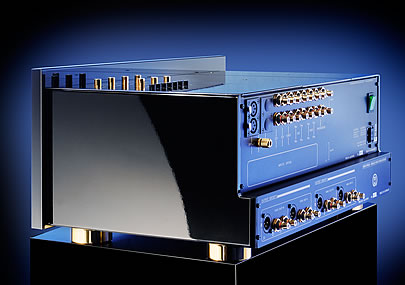
But it is vastly more accurate in terms of measurements. How did mbl achieve this? For me, it's a no-brainer—I unhesitatingly place the 6010D in the most rarified grouping, what I call the Statement Class.
This shift to the acoustic side is fairly pronounced. The 6010D does not sound like whatever solid-state preamp you might be using. Because of this I hesitate to describe the 6010D as neutral. Lovely as it is and even though I believe it quite true-to-life, it must be considered to have coloration, a coloration that is desperately desired by a great many audiophiles, including myself.
Comparison of 5011 and 6010D
When I go back to the 5011 after clocking some time with the 6010D, the subtle dynamic changes and timbral bloom disappear. Air and space are recreated more conventionally. Images possess sharper borders and have lots of space between them (this is where you can hear the higher stereo separation number). The frequency extremes aren't as integrated.
The 5011 paints with a broader brush that results in blunt strokes. It's hard to admit, but it's inescapable: the 5011 sounds dirty, grainy and mechanical by comparison.
With the 6010D back in stream, treble issues disappear. I'm tempted to say treble stridency is not possible with this machine—keeping everything equal, music that broached stridency with the 5011 does not with the 6010D.
At first I thought the 6010D was also darker than my reference mbl 5011 preamp. I knew this impression was at least partly due to the mass loading effect of 77 lbs vs. the 42 of the 5011. When I eliminated that factor by re-voicing with both preamps on the rack, it turns out they have precisely the same tonal balance.
It strikes me that the differences between these two preamps are rather analogous to some fine cables I just reviewed. The TARA Labs 0.8 series is a reference level cable by anyone's definition, but the company offers a much more expensive cable called The Zero. They are like the 5011 and 6010D. One doesn't measure better than the other, but one does come closer to the truth and in ways not to be found in the specifications.
Comparison to Statement Class Preamps
the Audio Note Japan M77 preamp
To give some perspective, I'm going to compare the 6010D to two other familiar members of the Statement Class. What I wrote about the all-tube Audio Note Japan M77 preamp in the context of my mbl 5011 review reads well today and only requires slight embellishment.
The M77 (MSRP $39,000) proved sobering on first acquaintance. It presents another side of the coin. (I say "another," as opposed to "the other," because the coin of the audio realm has many facets.)
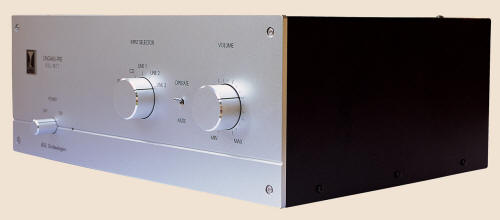
Strictly in terms of musical communication, the M77 remains without peer in my experience. Its sound is well formed and round. It doesn't come to you in a straight line, but kind of curves around and sidles up. When the M77 speaks, one just knows it's the truth. The audiophile layer of comprehension is misplaced in this context. One shouldn't analyze this sound to death.
The M77 has a silvery metallic signature, a much lighter tonal balance, and a thinner treble. It has a fondness for the higher harmonics. When bass notes strike, you immediately hear all these higher overtones. This does wonders for bounce and makes the sound light on its feet, but overall bass energy is woefully reduced.
This lovely voice (or coloration, if you will) is imposed on everything played back through the M77. It doesn't do as many of the things audiophiles talk about. My guess is it would fare only so-so in the measurement section of a Stereophile review.
the Lamm L2 Reference preamp
The Lamm L2 Reference preamp (MSRP $15,175) has no sense of "deep blackness between the notes." On the contrary, its blended and seamless continuity impress.
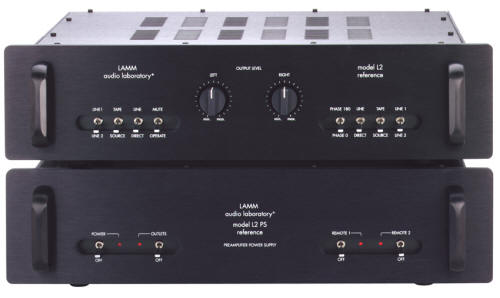
Like the mbl, the midrange is dominant. The Lamm's treble is sweet and round, its bottom a little ripe (warm), and its midrange on the cool side, verging on analytical. Tonal balance overall is much lighter than the mbl, if not as light as the M77.
The Lamm has a seriously acoustic, modern tube sound, even though all five tubes are in the separate power supply chassis. The control unit itself is 100% solid-state. Its presence and immediacy come from subtle, natural sounding cues. It is strong on resolution of vulnerable low-level info. Some might hear the Lamm's drop in dynamics and flatter, more recessed stage, as veiling. It reminds me of what I hear in certain concert halls, at least from my usual balcony seats. But snappy jazz tunes didn't have as much snap—dynamics are less impressive.
In its own way, the Lamm L2 had a timbral truthfulness as convincing as that of the ANJ M77, if done differently. Like the M77, it doesn't do many of the things audiophiles talk about.
The mbl 6010D rises to the level of natural articulation offered by the Lamm L2, if not quite up to the M77s timbral naturalism. But it manages to do everything audiophiles value. There are very few preamps that vanquish the major concerns so thoroughly.
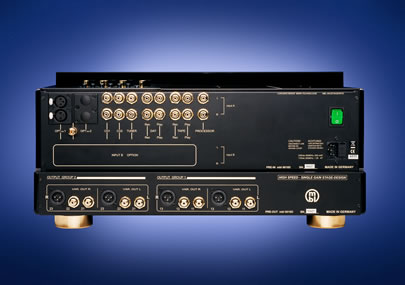
Functionality & Cosmetics
Like the mbl 5011, the 6010D has a staggering number of options. The flexibility of this component should satisfy any kind of audiophile, except home theatre aficionados in need of five channels.
There are two independent Output Groups, each equipped with one balanced and two single-ended connections. Each Group is capable of driving multiple sets of amplifiers and each Group has its own L / R Balance potentiometers, great for those of us with balance issues. Or say you're bi-amping using Output Group 1 for mid/treble and Group 2 for bass. You can do on the fly bass/treble equalization. On the output side, each source component has its own Input Level encoder to attenuate signal strength, so you can eliminate volume spikes when switching between sources.
Space is reserved on the rear panel for what looks like a template with two slots. These are the Option slots. Options can be specified when you place your order or they can be added later on. My sample came with a pair of RCA jacks in Option 2 labeled "MC Phono." This is for the brand new Phono module. Other options include the Balanced-In module, which allows for XLR input—the standard 6010D only comes with single-ended inputs.
The mbl 6010D is quiet as a church mouse. You can put your ear right up against the drivers and not hear a peep. Noteworthy also is the absence of cross-talk leakage from the various inputs. You can leave your tuner on while playing vinyl without dimly hearing it in the background.
If you thought the mbl 5011 was physically large, which it is (18 x 6.1 x 15.7"), wait 'til you spy the 6010D (21 x 9 x 12"). The 6010D is big and ungainly. It doesn't have the sleek, high-tech look of the rest of the mbl lineup. While depth is shallow, the height may present a challenge to your shelving. It wouldn't fit on my TAOC rack without special leg extensions. It looks serious and no-nonsense, more retro than contemporary, with its two big 24K gold-plated Selector knobs and glossy black and shiny finish. Most people found it imposing.
Setup
For most of the audition, I had the 6010D running through a TARA Labs IDAT power conditioner. Then one day it occurred to me—I've never seen one of these in mbl rooms at audio shows. Further, if mbl thought power conditioning was necessary, I'm sure they would market one of their own.
Definitely try running it directly into the wall, without conditioning. You will hear more tonal saturation and frequency integration, albeit with less control and focus. Sure, images get big and fuzzy and there's a slight increase in grain or dirt, but, on balance, you may find you can live with the tradeoffs—it depends on what you like and what your system needs. My wife preferred it with conditioning; I couldn't make up my mind. Interestingly, she brought up an analogy to trends in ladies' fashions: some women are willing to suffer clothes that constrict and shape in order to show their audience a voluptuous, if artificially assisted, figure; others put comfort first and buy loose, unrestricted garments and don't worry about their image.
Besides trying conditioning, leave the thing alone. With the 6010D, we are in the happy realm where tweaks are superfluous—there is nothing in this product's voice that needs tampering.
A couple of minor complaints: The last digit of the volume display occasionally fluctuates up or down even though you haven't touched anything. Don't be concerned; this is because it uses an analog potentiometer, not a digital one. Also, I would have liked more room between the RCA input jacks. It's too cramped; if adjacent ones are being used, access is restricted.;
The MC Phono Option
mbl 6010D or 5011preamps shipping now can be ordered with the new Phono Option. This consists of a plug-in board and a set of RCA's on the rear of the chassis utilizing one of the Option slots provided. You have a choice of MC, MM, or a combined MM/MC. My sample came with the MC board in Option 2 (MSRP $2020). The board you choose will fit either preamp.

Loading comes set at 100 Ω for the MC module and at maximum gain of 68dB, plenty for most low output MC cartridges. The short description in the preamp manual indicates that both are adjustable via plug-in resistors, which can be ordered from your dealer, but gives little information about the how to—more details would be useful. Older preamps with an available OPTION slot can be retrofitted, and it is recommended that your mbl dealer do the installation.
The manual does say the design distributes RIAA equalization among multiple amplifiers, which it claims increases headroom and reduces distortion.
How it Sounds
I wasn't sure what to expect. Given the price, I wondered, "How good could it be?"
Well, first of all, dynamics are off the chart. The claimed design benefits of distributing RIAA equalization among multiple amplifier stages—increased headroom and reduced distortion—are quite evident. The mbl MC jumps to the head of the class for dynamics, ousting the current chair holder, the ASR Basis Exclusive. This product has amazing headroom and, like all the other products I've auditioned from this German high-end manufacturer, it has mbl's signature voicing, which is to say it is basically artifact free and hews close to neutral. Oh, and it's a little warm, a little dark, and a little pretty sounding.
PRAT is superb. This is one of the fastest RIAA amplifiers on the market. The sound is crisp, but don't worry—the speed comes packaged in full-bodied, mbl-style images, maybe not as well developed as the Basis Exclusive, but more so than the Lamm LP2.
Moving down in grades, soundstaging is OK. The mbl MC floats its stage around the speaker plane, not nearly the same depth layering as the champion Basis Exclusive, whose stage begins behind the speakers and recedes deeply on Golden Era RCA LPs. Nor does the mbl MCs' stage have the decay trails of the ASR. You might say its stage is not as well organized.
Frequency extremes are a little exposed. Both of the more expensive phono stages mentioned above have better frequency integration and more developed timbre. The mbl MC images are more sharply drawn, a little truncated, and isolated in space; in the more expensive stages images are more life-like.
As you can see, I'm comparing the mbl MC Phono Option to much more expensive phono stages. While it doesn't measure up to the pacesetting ASR Basis Exclusive or the Lamm LP2, it is WAY BETTER than its price would suggest. I'd place it head to head with units in the $5 to $6K area. That means it's a great value. However, it isn't in the league of the 6010D linestage itself—it is closer in performance to the 5011 preamp.
Conclusion
mbl already achieved near Reference Class performance with their mid-line 5011 preamp. I found it competitive with much costlier units and rated it a best buy. But it is instantly obvious that their Reference Line 6010D preamp betters the less expensive by half 5011—and not necessarily in the ways you would expect. Look at the specs. Here you have a flagship product with closely matching numbers to the one-down model—in fact, two of the 5011 numbers are even better. And, yes, you can hear this.
Both preamps offer a host of sonic virtues including flat response across a wide bandwidth, excellent frequency integration, and scary good dynamics. They have no discernable distortions, no hint of grain or glare, and they are certainly among the most full-bodied preamps I've encountered, providing all the weight and support you could desire.
But after hearing the 6010D, the 5011 seems both mechanical and solid-state-ish. First, the 6010D turbo charges dynamic power. Big crescendos seem, oh, say 10% bigger. Headroom seems unlimited—breakup near to impossible. Throw at it what you will; you won't cause it to lose composure. Interestingly, I had thought all of this about the 5011—I still do—but the 6010D goes to another level entirely.
The other major difference is in the area we call inner life. The 6010D resolves details to a very fine particle size while developing the timbral envelope like no other piece of solid-state gear I've met. These two elements, ultra-fine resolution and robust timbre, imbue the 6010D with something like the inner life of a tube device. Given the 6010D's distinctly acoustic voicing, I strongly recommend audition before purchase.
But you won't find either of these elements on the spec sheet. As is often the case with Statement Class gear, what these products bring to the table is not found in the specifications.
Statement Class gear are superior regardless of price or topology. Among the three preamps in this Class I'm acquainted with, none offer such a complete spectrum of audiophile virtues as the mbl 6010D. Marshall Nack
mbl 6010D preamp
Retail: $23,800
MC Phono Option $2020
MM Phono Option $1540
MBL Akustikgeräte GmbH
web address:
www.mbl-germany.de
US distributor:
mbl of America
6615 E. Sleepy Owl Way
Scottsdale, AZ 85262
TEL: 480. 563. 4393
web address:
www.mbl-usa.com
